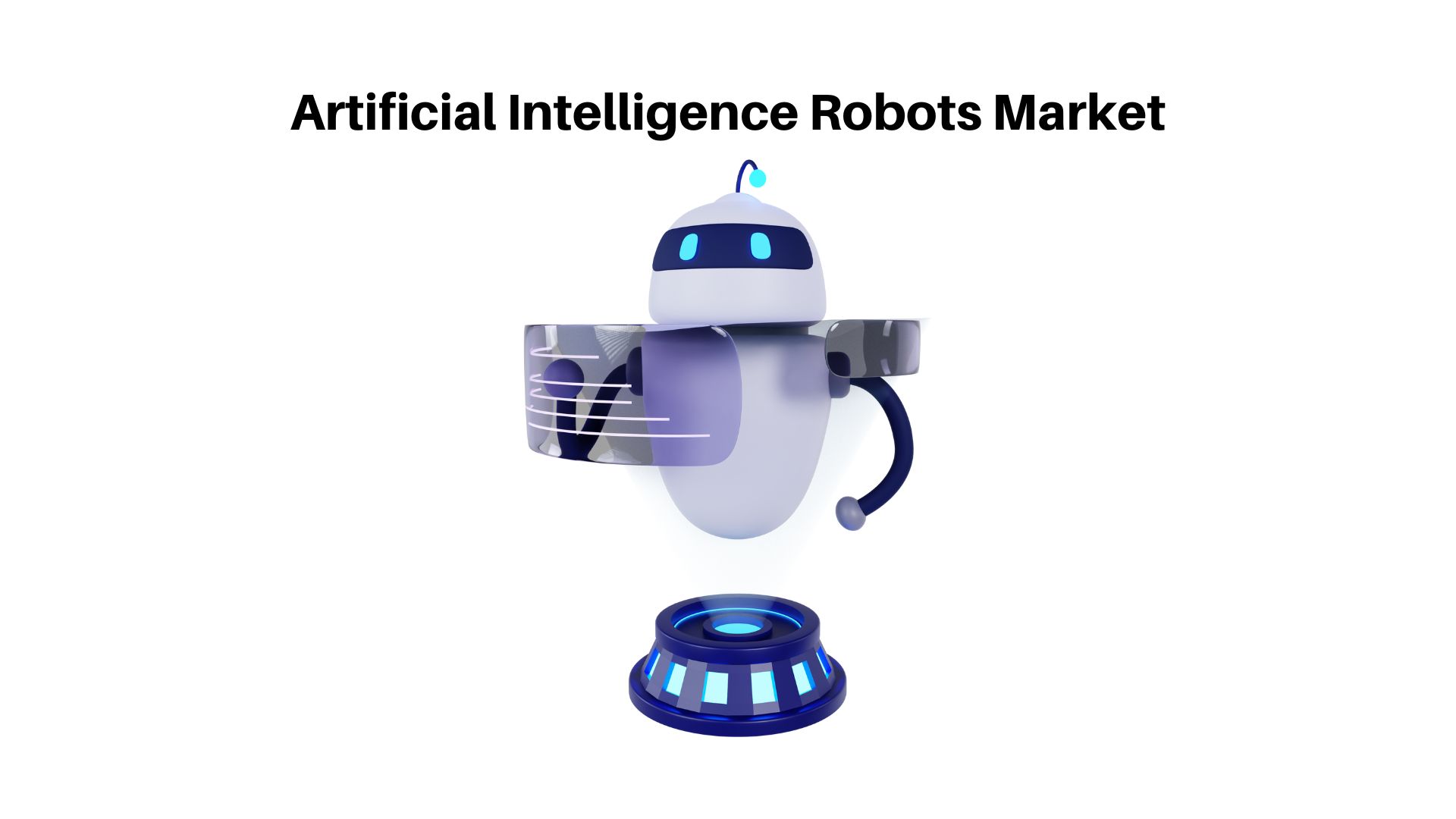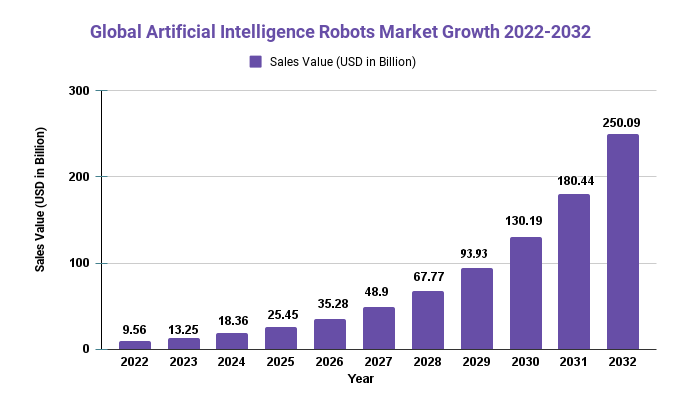Artificial Intelligence Robots Market Sales to Top USD 250.09 Bn in Revenues by 2033

Page Contents
Artificial Intelligence Robots Market Overview
Published Via 11Press: The global artificial intelligence robots market size is forecast to reach USD 250.09 billion by 2032 from USD 9.56 billion in 2022, rising at a compound annual growth rate (CAGR) of 38.6% during the forecast period.
The artificial intelligence (AI) robots market entails the application of advanced computing technologies to create robots that can perform various tasks autonomously, without human input. AI robots are programmed to carry out complex and sophisticated operations such as decision-making, planning, reasoning, and learning – tasks that necessitate high levels of cognitive processing and analysis.
The market for AI robots is being driven by an increasing need for automation across various industries, such as manufacturing, healthcare, retail, and logistics. AI robots can perform tasks faster, more accurately, and with greater precision than humans do, leading to increased productivity and efficiency.
The market for AI robots is segmented based on type, application, and geography. Types include service robots, industrial robots, and collaborative robots; applications include manufacturing, healthcare, logistics services, retail outlets, and others.
North America and Europe are currently the two leading markets for AI robots, due to the high demand for automation in these regions. However, Asia-Pacific is expected to experience rapid growth due to the increasing adoption of AI robots across manufacturing and other industries.
The major players in the AI robots market include ABB Ltd., Fanuc Corp., Yaskawa Electric Corp., Kuka AG, Universal Robots A/S, and IBM Corp. These companies are investing heavily in research and development to create more advanced and sophisticated AI robots to meet the growing demand for automation across various industries.

Key Takeaways
- The artificial intelligence (AI) robot market is a rapidly developing industry that utilizes advanced computing technologies to create robots capable of performing various tasks autonomously.
- AI robots are programmed to carry out complex and intricate tasks such as decision-making, planning, reasoning, and learning that require high levels of cognitive processing and analysis.
- The market for AI robots is being propelled forward by an increasing need for automation across various industries, such as manufacturing, healthcare, retail, and logistics.
- The market for AI robots is segmented based on type, application, and geography. Common types include service robots, industrial robots, and collaborative robots; their applications span manufacturing, healthcare, logistics services, retail stores, and beyond.
- North America and Europe are currently the two leading markets for AI robots, but Asia-Pacific is expected to experience rapid growth due to the increasing adoption of these robots across manufacturing and other industries.
Request For Sample Report: https://market.us/report/artificial-intelligence-robots-market/request-sample/
Regional Snapshot
North-America is expected to experience a substantial CAGR in the AI Robots Market during the forecast period.
Service robotics have been used extensively in the US for military and defense applications for many years. Drones are also employed in entertainment, media production, precision agriculture and inspection tasks. North America's AI robot market is growing due to an increasing demand for AI-integrated professional services robots – particularly medical and underwater ones.8
Drivers
- Increasing Demand for Automation: The primary driver of the AI robots market is an increasing need for automation across various industries. AI robots can perform tasks faster, more accurately, and with greater precision than humans do, leading to increased productivity and efficiency.
- Advancements in AI Technology: Recent breakthroughs in AI technology have allowed us to create more sophisticated and advanced AI robots that can perform complex tasks. Furthermore, advances in machine learning and natural language processing have given these AI robots the capacity to learn and improve their performance over time.
- Need for Cost-Effective Solutions: AI robots offer companies significant cost savings through reduced labor expenses and enhanced efficiency, leading to an increasing need for cost-effective automation solutions that are driving the adoption of AI robots.
- Rising demand for collaborative robots: Collaborative robots, also known as cobots, are designed to work alongside humans rather than replace them. These machines are becoming increasingly popular in manufacturing and other industries because they can enhance safety and productivity while decreasing accident risks.
Restraints
- High cost of development: Constructing sophisticated and advanced AI robots can be an expensive endeavor, which may hinder their adoption by smaller businesses or industries.
- Limited Capacity to Manage Unstructured Environments: While AI robots are highly proficient at performing repetitive tasks, they may lack the capacity to cope with unstructured situations such as unpredictable human behavior or changes to their environment.
- Concerns About Job Displacement: As AI robots become increasingly commonplace in various industries, job displacement fears have arisen due to their capacity for performing tasks previously done by humans. As a result, some industries have shown resistance or reluctance toward adopting AI robots.
- Lack of Technical Competency: Building and deploying AI robots necessitates specialized technical know-how, which may be an obstacle to adoption for some companies and industries that lack these abilities.
- Regulatory and Ethical Considerations: The use of AI robots raises regulatory and ethical concerns around data privacy, security, and accountability. Thus, clear regulations and guidelines must be put in place to guarantee the responsible use of these machines.
Opportunities
- Emerging Applications in New Industries: AI robots are becoming more prevalent beyond traditional manufacturing and industrial applications, being explored in fields such as healthcare, retail, and agriculture. This presents significant growth prospects for the AI robot market.
- Development of Customized AI Robots: As demand for AI robots continues to increase, companies have the chance to design customized robots tailored specifically for specific industry needs and applications. This can give businesses with highly specialized AI robots a competitive edge over others.
- Collaboration with Other Emerging Technologies: AI robots can be combined with other disruptive technologies like blockchain and the Internet of Things (IoT), creating novel use cases and applications. This offers companies an opportunity to develop creative solutions that take advantage of these advancements.
- Expansion of AI Robots in Emerging Markets: As AI robot adoption is still at an early stage in many emerging markets, there are significant growth prospects for the AI robot market. As these markets continue to develop and modernize, there will be increased demand for automation and advanced technologies.
- Focus on developing ethical and responsible AI: As concerns about data privacy, security, and accountability grow, companies that develop AI robots designed with these principles in mind may gain an edge in the market.
Challenges
- Data Quality and Availability: AI robots require large amounts of high-quality data to learn and enhance their performance. Unfortunately, data quality and availability can be an issue in certain industries, which could limit their effectiveness.
- Integration with Legacy Systems: Integrating AI robots with legacy systems can present a challenge, particularly in industries that have been slow to adopt automation technologies. This may hinder the adoption of AI robots in certain sectors.
- Lack of Standardization: Lack of standardization in the AI robots market can lead to interoperability issues between different systems and solutions, restricting their scalability and effectiveness.
- Limited AI Capabilities: Although AI robots can perform a wide range of tasks, they remain limited in their capacity to comprehend complex human behaviors and emotions. This could limit their usefulness for certain applications such as healthcare or customer service.
- Lack of Trust and Understanding: Unfortunately, there remains a lack of understanding and trust around AI robots, which may hinder their adoption in certain industries. Addressing these concerns will be key to the continued growth and acceptance of these intelligent agents.
Grow your profit margin with Market.us Get this Report
Recent Developments
- Increased Adoption of Collaborative Robots: Collaborative robots (cobots) are becoming more and more commonplace in industries like manufacturing where they can work alongside human workers to enhance efficiency and safety. This has caused an uptick in the adoption of collaborative robots across various sectors.
- Advances in Natural Language Processing: Technological advances in natural language processing have enabled AI robots to comprehend and respond more accurately to human language, making them more efficient in customer service applications as well as other fields.
- Expansion of AI Robots in Healthcare: AI robots are becoming increasingly used in healthcare to perform tasks such as patient monitoring and providing care, with the potential to lead to improved patient outcomes and reduced healthcare costs.
- Investment in AI Robotics Startups: There has been an unprecedented surge of investment in AI robotics startups, with numerous new companies entering the market with ground-breaking solutions and technologies.
- Integration with Other Emerging Technologies: AI robots are being integrated with other cutting-edge technologies like blockchain and IoT to create new applications and use cases. This is expected to lead to major advancements in the AI robot market.
Key Market Segments
Type
- Service
- Industria
Application
- Public Relations
- Stock Management
Key Market Players
- ABB
- Alphabet
- Amazon
- Asustek Computer
- Blue Frog Robotics
- Bsh Hausgerte
- Fanuc
- Hanson Robotics
- Harman International Industries
- IBM
- Intel
- Jibo
- Kuka
- LG
- Mayfield Robotics
- Microsoft
- Neurala
- Nvidia
- Promobot
- Softbank
Nature Insights
The Artificial Intelligence Robots Market is a rapidly developing industry that promises to revolutionize many sectors and applications. AI robots are being created and deployed across various settings, from manufacturing and logistics to healthcare and retail.
The market is being driven by several factors, including advances in AI technologies, rising demand for automation, and an increasing focus on efficiency and productivity. Nonetheless, there remain significant challenges that must be addressed such as data quality/availability issues, integration with legacy systems issues, and lack of standardization.
Recent developments in the market, such as the increased adoption of collaborative robots and advances in natural language processing, are predicted to fuel growth and innovation within this sector. Investment in AI robotics startups is also anticipated to speed up the development of new solutions and technologies.
The expansion of AI robots in healthcare is an area that holds great promise, as it could significantly improve patient outcomes and reduce healthcare costs. However, there are ethical and regulatory concerns to consider such as data privacy and accountability.
Report Scope
| Report Attribute | Details |
| The market size value in 2022 | USD 9.56 Bn |
| Revenue forecast by 2032 | USD 250.9 Bn |
| Growth Rate | CAGR Of 38.6% |
| Regions Covered | North America, Europe, Asia Pacific, Latin America, and Middle East & Africa, and Rest of the World |
| Historical Years | 2017-2022 |
| Base Year | 2022 |
| Estimated Year | 2023 |
| Short-Term Projection Year | 2028 |
| Long-Term Projected Year | 2032 |
Contact us
Contact Person: Mr. Lawrence John
Market.us (Powered By Prudour Pvt. Ltd.)
Tel: +1 718 618 4351
Send Email: [email protected]
FAQ.
Artificial intelligence (AI) robots are devices equipped with cutting-edge AI technologies that enable them to perform tasks autonomously or with minimal human involvement. They're programmed to learn from their environment and adjust their behavior according to changing conditions.
AI robots are finding use in a variety of fields, such as manufacturing, logistics, healthcare, retail, and agriculture. They're capable of performing tasks such as assembly, packaging, inventory management, patient monitoring, and customer service.
AI robots offer significant improvements in efficiency, productivity, and safety. They are capable of performing tasks more quickly and accurately than humans, as well as working in hazardous environments. Furthermore, they free up human workers to focus on more complex or strategic jobs.
Some of the issues facing AI robots include data quality and availability, integration with legacy systems, lack of standardization, limited AI capabilities, as well as concerns around data privacy and accountability.
The AI robots market is expected to experience rapid growth over the coming years, driven by advances in AI technologies and increasing demand for automation. This market will expand beyond traditional industrial applications into new sectors such as healthcare, retail, and agriculture. Furthermore, investments in AI robotics startups are anticipated to further fuel innovation and expansion within this space.
The team behind market.us, marketresearch.biz, market.biz and more. Our purpose is to keep our customers ahead of the game with regard to the markets. They may fluctuate up or down, but we will help you to stay ahead of the curve in these market fluctuations. Our consistent growth and ability to deliver in-depth analyses and market insight has engaged genuine market players. They have faith in us to offer the data and information they require to make balanced and decisive marketing decisions.



